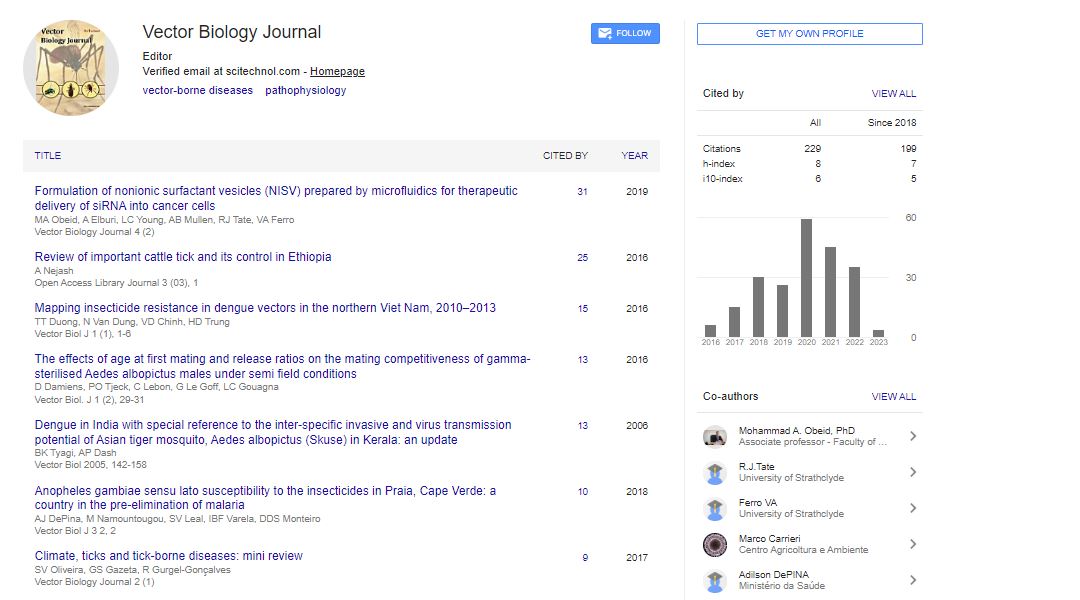Opinion Article, Vector Biol Vol: 8 Issue: 1
Tungiasis Skin Parasitic Disease
Marcus Ruby*
Department of Biology, University of Copenhagen, Copenhagen, Denmark
*Corresponding Author: Marcus Ruby
Department of Biology, University of
Copenhagen, Copenhagen, Denmark
E-mail: marcus12ruby@gmail.com
Received date: 20 February, 2023, Manuscript No. VBJ-23-95804;
Editor assigned date: 22 February, 2023, PreQC No. VBJ-23-95804(PQ);
Reviewed date: 09 March, 2023, QC No VBJ-23-95804;
Revised date: 16 March, 2023, Manuscript No. VBJ-23-95804(R);
Published date: 23 March, 2023, DOI: 10.4172/2473-4810.1000260.
Citation: Ruby M (2023) Tungiasis Skin Parasitic Disease. Vector Biol 8:1.
Description
Tungiasis also known as jigger infestation or sand flea disease, is a neglected tropical skin disease caused by the female sand flea Tunga penetrans. This parasitic condition affects millions of people in resource-poor communities in tropical and subtropical regions of Africa, South America, and the Caribbean. Tungiasis poses significant health and socio-economic challenges, yet it often goes unnoticed and untreated, leading to severe consequences for affected individuals and communities. The life cycle of the sand flea begins when the female flea burrows into the skin of its host, usually the feet but also other parts of the body. The flea feeds on the host's blood, grows in size, and lays eggs within a few weeks the eggs hatch and release larvae which fall to the ground and burrow into the soil to mature into adult fleas. Humans can become hosts when they come into contact with infested soil or surfaces, such as walking barefoot or sitting on infested furniture or floors.
Tungiasis can cause a range of symptoms, including intense itching, pain, inflammation, and ulceration. The presence of the sand flea in the skin can also lead to secondary bacterial infections, which can cause further complications. Walking, wearing shoes, or performing daily activities become challenging for those affected by tungiasis, leading to mobility impairment and a reduced quality of life. The condition can also cause social stigmatization and discrimination, as the visible skin lesions can be mistaken for other conditions and lead to misconceptions about personal hygiene or cleanliness. Tungiasis predominantly affects vulnerable populations including children, elderly individuals, and individuals with limited access to healthcare, clean water, and sanitation. Poverty, overcrowding, and a lack of awareness about preventive measures contribute to the high prevalence of tungiasis in these communities. In addition, climate change, deforestation, and urbanisation can influence the distribution and abundance of the sand flea, increasing the risk of tungiasis in affected regions.
Despite its significant impact on health and well-being tungiasis remains neglected in terms many affected individuals do not have access to healthcare or cannot afford treatment, resulting in chronic infestations and long-term complications. There is also a lack of diagnostic tools and standardised treatment protocols for tungiasis, making it challenging to manage and control the disease effectively. Prevention and control of tungiasis require a multifaceted approach. Health education and community engagement are crucial in raising awareness about the disease and promoting preventive measures, such as wearing shoes, using protective measures on infested surfaces, and maintaining proper hygiene practises. Environmental interventions, such as improving housing conditions, sanitation, and pest control measures, can also help reduce the prevalence of the sand flea in infested areas. Access to healthcare and affordable treatment options, including the removal of the embedded fleas using sterilized instruments and the management of secondary infections, are essential for affected individuals. This includes the development of diagnostic tools, standardised treatment protocols, and novel strategies for disease control, such as the use of insecticides, repellents, or biological control methods. Collaboration between governments, nongovernmental organisations, academia, and affected communities is essential to drive action, mobilise resources, and implement effective interventions for taeniasis control. Efforts to combat tungiasis should also be integrated into broader health and development programmes. Recognising the social and economic consequences of the disease, interventions should aim to address the underlying determinants of tungiasis, including poverty, inadequate housing, and lack of access to basic health services.
 Spanish
Spanish  Chinese
Chinese  Russian
Russian  German
German  French
French  Japanese
Japanese  Portuguese
Portuguese  Hindi
Hindi 